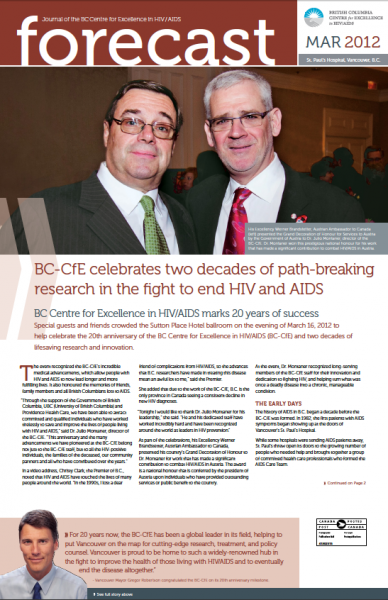BC Centre for Excellence in HIV/AIDS marks two decades of path-breaking research in the fight to end HIV and AIDS
BC-CfE celebrates 20 years of success
 Special guests and friends crowded the Sutton Place Hotel ballroom on the evening of March 16, 2012 to help celebrate the 20th anniversary of the BC Centre for Excellence in HIV/AIDS (BC-CfE) and two decades of lifesaving research and innovation.
Special guests and friends crowded the Sutton Place Hotel ballroom on the evening of March 16, 2012 to help celebrate the 20th anniversary of the BC Centre for Excellence in HIV/AIDS (BC-CfE) and two decades of lifesaving research and innovation.
The event recognized the BC-CfE’s incredible medical advancements, which allow people with HIV and AIDS to now lead longer and more fulfilling lives. It also honoured the memories of friends, family members and all British Columbians lost to AIDS.
“Through the support of the Government of British Columbia, UBC and Providence Health Care, we have been able to attract committed and qualified individuals who have worked tirelessly to save and improve the lives of people living with HIV and AIDS,” said Dr. Julio Montaner, director of the BC-CfE. “This anniversary and the many advancements we have pioneered at the BC-CfE belong not just to the BC-CfE staff, but to all the HIV-positive individuals, the families of the deceased, our community partners and all who have contributed over the years.”
In a video address, Christy Clark, the Premier of B.C., noted that HIV and AIDS have touched the lives of many people around the world. “In the 1990s, I lost a dear friend of complications from HIV/AIDS, so the advances that B.C. researchers have made in treating this disease mean an awful lot to me,” said the Premier.
She added that due to the work of the BC-CfE, B.C. is the only province in Canada seeing a consistent decline in new HIV diagnoses.
“Tonight I would like to thank Dr. Julio Montaner for his leadership,” she said. “He and his dedicated staff have worked incredibly hard and have been recognized around the world as leaders in HIV prevention.”
As part of the celebrations, his Excellency Werner Brandstetter, Austrian Ambassador to Canada, presented his country’s Grand Decoration of Honour to Dr. Montaner for work that has made a significant contribution to combat HIV/AIDS in Austria. The award is a national honour that is conferred by the president of Austria upon individuals who have provided outstanding services or public benefit to the country.
At the event, Dr. Montaner recognized long-serving members of the BC-CfE staff for their innovation and dedication to fighting HIV, and helping turn what was once a deadly disease into a chronic, manageable condition.
The early days
The history of AIDS in B.C. began a decade before the BC-CfE was formed. In 1982, the first patients with AIDS symptoms began showing up at the doors of Vancouver’s St. Paul’s Hospital.
While some hospitals were sending AIDS patients away, St. Paul’s threw open its doors to the growing number of people who needed help and brought together a group of committed health care professionals who formed the AIDS Care Team.
Despite the establishment of the AIDS Care Team, within a decade of the appearance of the first case of HIV, a British Columbian was dying of the disease almost every day. With little effective treatment to offer, for most the virus was a death sentence. In response, the BC Ministry of Health established the BC-CfE.
“When I started in 1984, we had described the virus but we had no treatments. If a person received a diagnosis, it was bad news,” recalls Dr. Michael O’Shaughnessy, founding director of the BC-CfE.
Under Dr. O’Shaughnessy’s leadership, the BC-CfE established the HIV/AIDS Drug Treatment Program, a research and treatment program designed to ensure that all medically eligible persons living with HIV in British Columbia have access to free antiretroviral therapy.
The year everything changed
In 1996, the concept of combination therapy, known as highly active antiretroviral therapy (HAART), was introduced. Its release coincided with the opening of the 1996 International AIDS Society (IAS) conference in Vancouver. There, new evidence supporting HAART was presented.
“In Vancouver, we stood up at the podium to say that this is what the new data showed, that this was the new way forward, that this was the new way to treat HIV,” said Dr. Montaner. “It transformed the outcome of this epidemic.”
Evidence presented at the conference would lead to the immediate introduction of the B.C.-developed HAART as a therapeutic strategy for HIV.
Treatment as Prevention
Dr. Montaner first introduced the groundbreaking concept of Treatment as Prevention at the Toronto 2006 IAS conference. The strategy called for expanding HIV testing and increased access to HAART to curb the spread of HIV/AIDS.
The government of B.C., the first in Canada to support the concept of Treatment as Prevention, announced a $48 million pilot project called Seek and Treat for Optimal Prevention of HIV/AIDS (STOP HIV/AIDS) in 2010. The pilot is aimed at expanding access to treatment among vulnerable and hard-to-reach populations. The Treatment as Prevention strategy to control HIV has gained the support of key international organizations including the Stephen Lewis Foundation, the Clinton Foundation, the World Health Organization (WHO) and the Joint United Nations Program on HIV/AIDS (UNAIDS)
“We are blessed to have people of the talent of Julio Montaner and those at the BC-CfE,” said Professor Stephen Toope, president of UBC. “People who are passionate, people who are extraordinarily talented and, frankly, people who are courageous in what they choose to undertake in their life’s work.”
Dr. Montaner echoed the sentiments. “I look back with great pride and satisfaction at the far reaching impact our work has had on this devastating disease. However, I know that our work is not yet done.”
